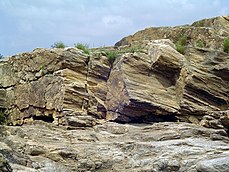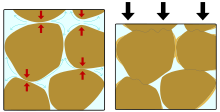
Back Afsettingsgesteente Afrikaans Roca sedimentaria AN صخر رسوبي Arabic Roca sedimentaria AST अवसादी शैल AWA Çökmə süxurlar Azerbaijani Ултырма тау тоҡомдары Bashkir Асадкавыя горныя пароды Byelorussian Асадкавыя горныя пароды BE-X-OLD Седиментни скали Bulgarian





Sedimentary rocks are rocks formed from sediment. They are deposited over time, and often show layers which can be seen in cliffs. Other types of rock are igneous rock and metamorphic rock.
Sediments are usually formed from matter which falls to the bottom of oceans and lakes. The matter includes tiny pieces of other rocks, and dead animals, plants and microorganisms. Also, inorganic chemicals may be precipitated from solution in the water. The three most common sedimentary rocks are limestone, sandstone and shale.[1]
Sedimentary rocks cover 75–80% of the Earth's land area, but they make up only 5% of the Earth's crust. The relative abundances of the different types of sedimentary rocks are:
- ↑ Blatt H; Middleton G. & Murray R. 1980. Origin of sedimentary rocks. Prentice-Hall. ISBN 0-13-642710-3